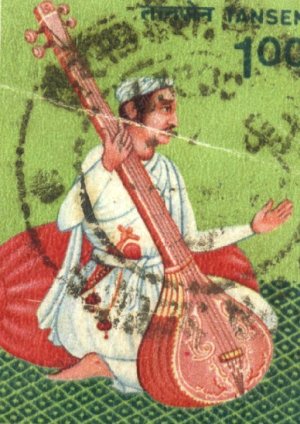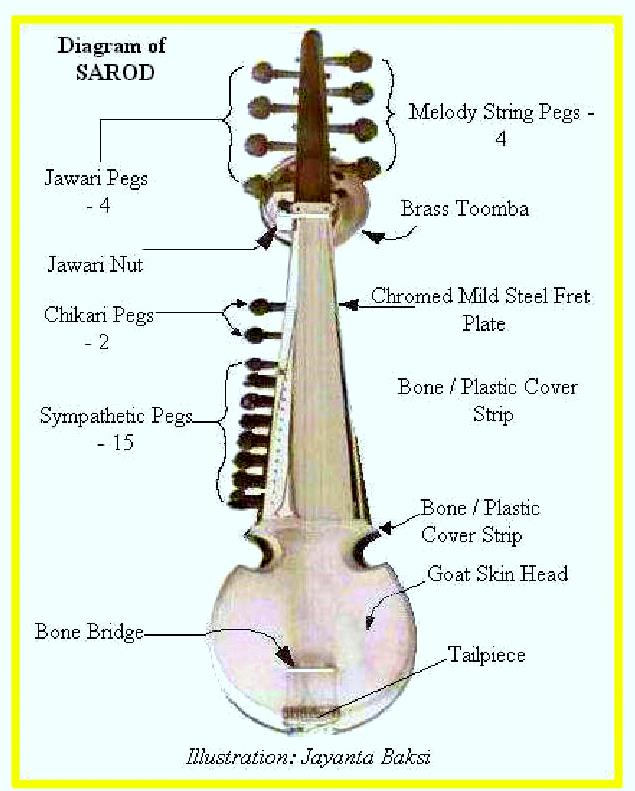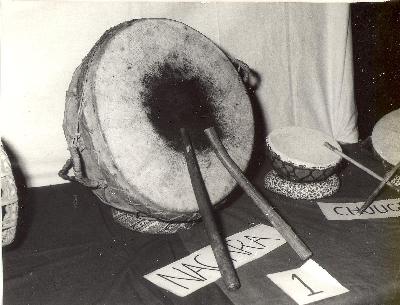Originally, in India
there was only one system of music, but during the medieval period the North
India came under the impact of the diverse musical influences of the Islamic
world-particularly Persian, which led to the division of the Indian Music into two
distinct schools the Hindustani (North Indian) and Karnataka (South
Indian).

- But the basic features in both
schools of music were common.
- The Indian music is of two types
Marga-Sangit (mystical) and Desi Sangit (secular).
- The cause of music is pleasant
sound termed in India “Nada”.
Indian music is divided into “Ragas” or melody-types.
- There are ten major “Ragas” or
parent scales of which the most important are Yaman, Bilawata
Khamaj, Bhairava, Purvi, Marwa, Kafi, Asawari, Bhairavi and
Todi.
- The major Ragas or parent scales
are further sub-divided into Ragas and Raginis so that we have about 200
types of melodies.
- Each Raga must have five notes,
one principal one (called Vadi), one second important note (called
Samvadi) and the rest assistant notes (called Anuvadi).
- Ragas are sung in various speeds
and some move in a certain pitch.
Music has also its
rhythmic beats which are divided into ‘tala’, ‘laya’ and ‘matra’.
- ‘Tala is a complete cycle of a
metrical phrase composed of a fixed number of beats.
- ‘Laya’ is tempo-slow, medium,
fast.
- ‘Matra’ is the smallest unit of
the ‘Tala’.

Thus
the gamut of several notes woven into a composition may be called a ‘Raga’. The
Ragas can be sung without any instrumental accompaniment but generally take
‘Tabla’ (drim) for the purpose besides any stringed instrument.
They
are sung at particular seasons and time of the day or night.
Principal Indian
Ragas
- Indian classical music consists of six principal Ragas and thirty Raginis.
- Music is adapted to the season of
the year, hours of the day and mood of the performer.
- The Indian year is divided into
six seasons and each season has its own Raga.
- The principal Ragas are Bhairavi,
Hindol, Megha, Sriraga, Deepak and Malkaus.
- According to Indian concept of
Music, each Raga is a demigod, wedded to five Raginis.
- Thus there are six Ragas and
thirty Raginis.
The day is divided into six parts, and
each is allotted to a particular Raga.
- Bhairav Raga is usually sung from
4 a.m. to 8 a.m.
- Hindol from 8 a.m. to 12
noon.
- Megha from 12 noon to 4 p.m.
- Sriraga from 4 p.m. to 8
p.m.
- Deepak from 8 p.m. to 12
midnight
- Malkaus from 12 midnight to 4 a.m.
*****************************************************************
- Beginning in the 13th century,
with the establishment of Delhi Sultanate Islamic hegemony in the north is
commonly believed to be associated with evolution of two distinct styles
of musical practice in India.
- The Hindustani of north and the
Karnataka of the south.
- Although the Hindustani system
considered different from the Karnataka by virtue of presence of Persian
and Turkish features in the former- musicians from Persia and central Asia
were associated with courts in the North at least until the late
seventeenth century.
Today
the two main classical styles in India correspond geographically the linguistic
areas of Indo-Aryan based languages in the north and Dravidian based languages
in the south.
- Although analytically both can be
considered two variants of one underlying system, the two systems are
considered in India to distinct constituting separate theory systems,
histories, composition and performers.
- Common to both systems are the
fundamental concepts of pitch (svara) melody type (raga known as rag in
the north and ragam in the south) and meter (tala, tal in the north and
talam in the south).
- Both also use similar, types of
performance ensembles with a vocalist or instrumentalist as soloist, a
drummer as rhythmic accompanist and a drone provided by a tanpura.
- In the case of vocal soloist, a
melodic accompanist on an instrument is also present.
|
Hindustani Music
|
Karnataka Music
|
 

Once the alap is ended the composition proper is performed.
The composition is set to a recurring rhythmic cycle (tala).
Texts of most compositions are devotional, although these can
take on a remarkably wide range of manifestations ranging from abstractly
spiritual to the highly erotic.
|
Karnataka performance practice tends to give greater emphasis
to the actual composition than is the case for Hindustani music.
The fixed
and memorized composition along with its memorized variations are longer and
constitute proportionately much more a given performance than in the north.
|
|
|
|
The
principal Indian musical instrument as may be divided into four classes :
(i)
stringed instruments, which have strings made of steel, copper or brass wires
or silken cords. Such instruments are veena, sarod, sitar, tanpura,
rabbad:

(ii)
instruments played with bow, such as sarangi, dilruba, mayuri etc.,

(iii)
drum instruments, which are played with bands on sticks, such as pakhawaj,
tabla, naggara, dholak etc.,

(iv)
wind or mouth instruments, which are played by blowing full or half breaths,
such as, flute, bin, surna etc.


